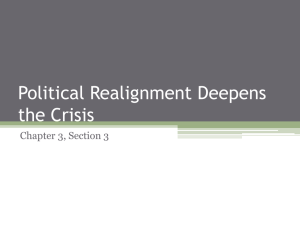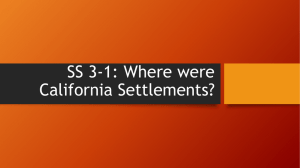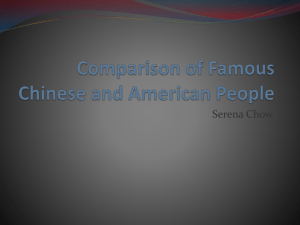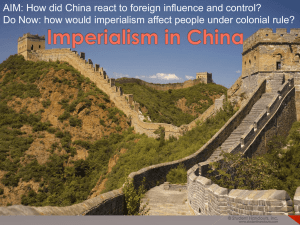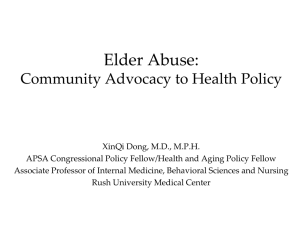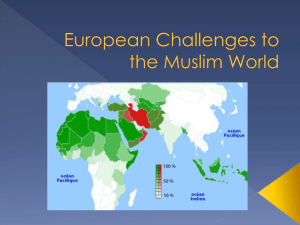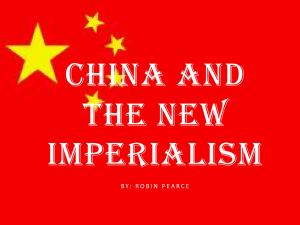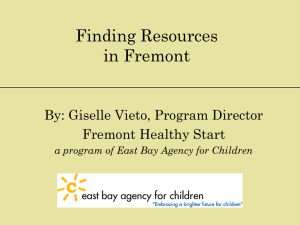1800_s People - El Rancho Unified School District
advertisement
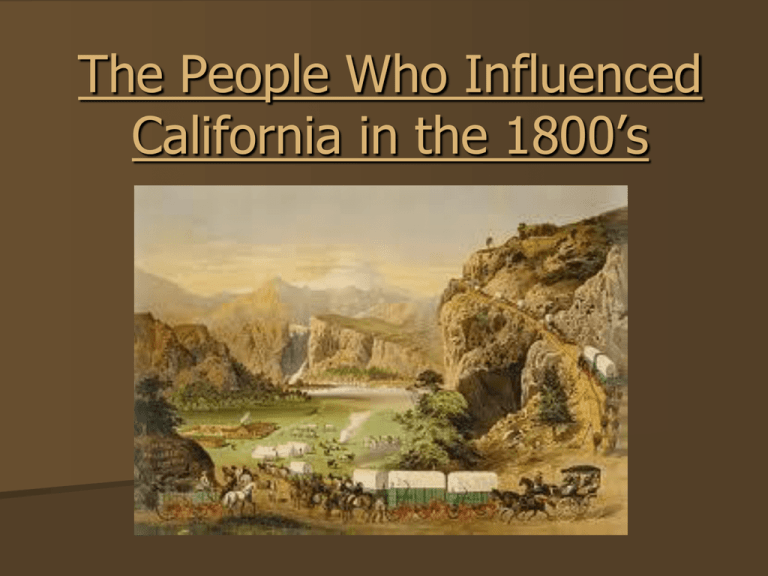
The People Who Influenced California in the 1800’s The Exploration of California John C. Fremont Jedediah Smith John Bidwell John Charles Fremont Traveled from Missouri to the West. His lively map reporting enticed Americans, from the east coast, to travel to California Traveled to the Great Salt Lake region in 1843 The Mormons were encouraged, by Fremont’s detail, to travel to California John C. Fremont Highlights HARPER'S WEEKLY: JULY 13, 1861. Ran for political office in 1856. Fought in the Civil War. First Senator from California Governor of Arizona,1878-81 Died in New York City, July 13, 1890 View of the Wind River Range. Illustration from Fremont's 1st and 2nd Western Expedition Book published 1845. 1842 and 1843, Eruptions of Mount St. Helens and Mount Rainier, and map detail of the peaks of the Cascade Range (Published in 1845) Fremont in the Klamath On his journey from California, Fremont and his expedition party were attacked by Indians in Southern Oregon. Jedediah Smith 1799-1831 “I wanted to be the first to view a country on which the eyes of a white man had never gazed and to follow the course of rivers that run through a new land." Jedediah Smith Traveled to Arizona through Mojave Desert 1st American to travel through California and through the southwest. He also crossed the Great Basin of California “The heat became so unbearable Smith and his men had to bury themselves in sand to keep cool. “ Jedediah Smith’s Travels John Bidwell Traveled from Missouri to California He fought alongside John C. Fremont in the Mexican War John Bidwell Travels through California He seemed considerably agitated, and reported that at the Mission of San José, some fifteen miles this side of the town of San José, all the men had been arrested and put in prison by General Vallejo, Mexican commander- in-chief of the military under Governor Alvarado, he alone having been sent back to tell Marsh and to have him come forthwith to explain why this armed force had invaded the country. We reached Marsh’s after dark. John Bidwell Travels to Fort Sutter “We got out of provisions and were about three days without food. Game was plentiful. but hard to shoot in the rain. Besides, it was impossible to keep our old flint-lock guns dry, and especially the powder dry in the pans. On the eighth day we came to Sutter’s settlement; the fort had not then been begun. Sutter received us with open arms and in a princely fashion, for he was a man of the most polite address and the most courteous manners, a man who could shine in an society. Moreover, our coming was not unexpected to him. “ John Bidwell’s Diary John Bidwell Meets John Sutter We got out of provisions and were about three days without food. Game was plentiful. but hard to shoot in the rain. Besides, it was impossible to keep our old flint-lock guns dry, and especially the powder dry in the pans. On the eighth day we came to Sutter’s settlement; the fort had not then been begun. Sutter received us with open arms and in a princely fashion, for he was a man of the most polite address and the most courteous manners, a man who could shine in an society. Moreover, our coming was not unexpected to him. John Bidwell’s Diary James Beckwourth 1st African-American who documented his travels through California Born as a slave Lived with Crow Indians Fought in California Revolution He was a scout for John C. Fremont In 1850 in the Sierra Nevada, Beckwourth found an important and safer pass that led pioneers and gold seekers to the fields of California (now called "Beckwourth Pass"). Beckwourth Pass The Gold Rush John Sutter James Marshall Sam Brannan John Sutter (1803-1880) He was a trader who traveled through the Oregon trail, San Francisco Bay, Hawaiian Island to Sitka, Alaska He established a settlement in Yerba Buena (east of San Francisco) He made his headquarters along the American River at junction with Sacramento River Established Fort Sutter Died a poor man Fort Sutter It was established in 1841. It was trading post for Americans traveling through California. Also, Sutter created a myriad of relationships with immigrants which provided political protection when the Mexican War occured. Fort Sutter With the discovery of gold, Fort Sutter collapsed because of the influx of gold rushers and squatters. Sutter described it this way: "Everyone left, from the clerk to the cook, and I was in great distress." Discovery of Gold “I went in the race and picked up several pieces of this gold, several of the laborers gave me some which they had picked up, and from Marshall I received a part. I told them that I would get a ring made of this gold as soon as it could be done in California; and I have had a heavy ring made, with my family’s cost of arms engraved on the outside, and on the inside of the ring is engraved, “The first gold, discovered in January, 1848.” Sutter’s Diary James Marshall He was building a sawmill for John Sutter. He discovered gold nuggets on January 24, 1848. Sutter’s Sawmill James Marshall at Sutter's Sawmill, Coloma, California, 1851 James Marshall discovery of gold I went down as usual, and after shutting off the water from the race I stepped into it, near the lower end, and there, upon the rock, about six inches beneath the surface of the water, I discovered the gold. I then collected four or five pieces and went up to Mr. Scott (who was working at the carpenter's bench making the mill wheel) and the pieces in my hand and said, 'I have found it.' 'What is it?' inquired Scott. 'Gold,' I answered. 'Oh! No,' returned Scott, 'that can't be!' I replied positively, 'I know it to be nothing else.'" Sam Brannan He publicized the discovery of gold Became California’s 1st millionaire by selling goods and supplies to miners. Died poor and lonely “Gold! Gold on the American River!“ Sam Brannan yelled in the streets The Gold Rush The Women of the 1800’s Mary Tape Louise Clapp Helen Hunt Jackson Bernanda Ruiz Louise Clapp Louise wrote the life and times of living near the gold mines. She wrote letters to her sister, Molly, who lived in New England. Her letters were published under Dame Shirley in 1854 Dame Shirley “Really, everybody ought to go to the mines just to see how little it takes to make people comfortable in the world.” By Dame Shirley Helen Hunt Jackson She wrote about the unfair treatment of the Indians at the hands of the government. Her most famous books were Ramona and A Century of Dishonor A quote from A Century of Dishonor The history of the Government connections with the Indians is a shameful record of broken treaties and unfulfilled promises. The history of the border white man's connection with the Indians is a sickening record of murder, outrage, robbery, and wrongs committed by the former, as the rule, and occasional savage outbreaks and unspeakably barbarous deeds of retaliation by the latter, as the exception. A quote from A Century of Dishonor “Cheating, robbing, breaking promises-these three are clearly things which must cease to be done. One more thing, also, and that is the refusal of the protection of the law to the Indian's rights of property, "of life, liberty, and the pursuit of happiness." Mary Tape Joseph and Mary Tape, tried to enroll their 8-year-old U.S.-born daughter in San Francisco's all-white Spring Valley School in September 1884. Joseph, Emily, Mamie, Frank & Mary Tape circa 1884–85 California Political Code had been repealed by the state legislature in April 1880. Section 1662 of the revised Code read: Every school, unless otherwise provided by law, must be open for the admission of all children between six and twenty-one years of age residing in the district; and the board of trustees, or city board of education, have power to admit adults and children not residing in the district whenever good reason exists therefore. Trustees shall have the power to exclude children of filthy and vicious habits, or children suffering from contagious or infectious diseases. Mary Tape’s Letter to School Board, 1885 Dear Sirs: I see that you are going to make all sorts of excuses to keep my child out off the Public schools. Dear sirs, Will you please to tell me! Is it a disgrace to be Born a Chinese? Didn’t God make us all!!! What right have you to bar my children out of the schools because she is a Chinese Descend…. Do you call that a Christian act to compel my little children to go so far to a school that is made in purpose for them. My children don’t dress like the other Chinese…. Her playmates is all Caucasians ever since she could toddle around. If she is good enough to play with them! Then is she not good enough to be in the same room and studie with them?… It seems no matter how a Chinese may live and dress so long as you know they Chinese. Then they are hated as one. There is not any right or justice for them. 1885 Court Ruling On 9 January 1885, Superior Court Judge McGuire decided the case in favor of the parents, writing, “To deny a child, born of Chinese parents in this State, entrance to the public schools would be a violation of the law of the State and the Constitution of the United States.” School Superintendent Andrew Jackson Moulder lobbied a compliant state legislature to introduce Assembly Bill 268, which was passed under an “urgency provision.” ...and also to establish separate schools for children of Mongolian or Chinese descent. When such separate schools are established Chinese or Mongolian children must not be admitted into any other schools. Bridget "Biddy" Mason (1818-1891) She was born a slave Traveled with Robert Smith who was a Mormon and moving to Utah territory She handled his cattle Biddy settled in California She petitioned to be freed. One of the first women to own land in Los Angeles Buried in Boyle Heights (Evergreen Cemetery) With the Compromise of 1850, Mason challenged her freedom Compromise of 1850 California. would be free Mexican states would be divided they decide if they want slaves slave trade would end in D.C. but not slavery California Constitution Bernarda Ruiz brokered a peace treaty between Pico and Fremont during the Mexican War The peace meeting was on January 13, 1847 The peace meeting was at the Cahuenga Pass She led a peace compromise between Andres Pico and John C. Fremont Andres Pico John Charles Fremont Bennett Riley He was responsible for creating California’s constitution in 1849. The Californians met in Monterey from Sept. to Oct. It was ratified on Nov. 13, 1849. California was admitted to the union in 1850 as the 31st state. California Constitution Hubert Howe Bancroft, in describing the convention, stated: “Never in the history of the world did a similar convention come together. They were there to form a state out of unorganized territory; out of territory only lately wrested from a subjugated people, who were allowed to assist in framing a constitution in conformity with the political views of the conquerors." California Delegates “June 3, 1849, issued by Bvt. Brigadier-General Bennet Riley, U.S.A., the then Military Governor, which recommended "the formation of a State constitution or a plan for a territorial government." According to this proclamation, the convention was to consist of thirty-seven delegates, to be chosen as follows: two from San Diego; four from Los Angeles; two from Santa Barbara; two from San Luis Obispo; five from Monterey; five from San Jose; five from San Francisco; four from Sonoma; four from Sacramento; and four from San Joaquin. “ General Riley issued this proclamation to the People of California "The people are now called upon to form a government for themselves, and to designate such officers as they desire to make and execute the laws. That their choice may be wisely made, and that the government so organized may secure the permanent welfare and happiness of the people of the new State, is the sincere and earnest wish of the present Executive, who, if the Constitution be ratified, will, with pleasure, surrender his powers to whomsoever the people may designate as his successor." ( part of the proclamation) Peter Burnett First Civilian governor for California in 1849 Mariano Guadalupe Vallejo He protected the interest of the Californians The Treaty of GuadalupeHidalgo was supposed to protect the rights of the Californians. Vallejo lost much of his land and power with the Gold Rush. American Settlers took Vallejo’s landholdings. Pio Pico Last Mexican Governor of California He served a brief term in 1832 and again from March 1845 to July 1846. One of the key events during his administration was the finalization of the secularization of California’s missions. Chinese Immigrants Influenced California’s Economy Chinese Influence in the Railroad The great curved trestle at Secret Town was the largest structure of its type on the railroad. In this remarkable photograph, which shows the Chinese laborers bringing a never ending supply of dirt from the mountainside, the trestle is being filled in to eliminate the fire hazard and avoid replacement of the aging timbers. Chinese Working in California In 1851, 3,000 Chinese arrived in California to worked the mines. In 1852, 20,000 arrived. The worked was primarily in Calaveras, El Dorado and Amador counties Chinese working the gold mines The Chinese and the Railroad In 1865, there was a labor shortage building the Central Pacific railroad. There was friction between the Irish immigrants and the Chinese immigrants. The Chinese proved to be reliable and efficient workers. Charles Crocker contracted the Chinese to work on the railroad Wherever we put them, we found them good," Crocker recalled, "and they worked themselves into our favor to such an extent that if we found we were in a hurry for a job of work, it was better to put Chinese on at once." Chinese labor force was reliable and efficient The Chinese were punctual, willing and well-behaved. They were known as “Celestials” for their spiritual beliefs. The Caucasian counterparts began to feel resentment towards the Chinese workers. How were the Chinese treated in US in the political? Who is the woman in the illustration? Why is the man sitting down? What are the men are doing? What words are on the poster? Website used for this power point Coloma Valley Historical Society http://www.coloma.com/gold/ Mary Tape http://www.berkeleyheritage.com/essays/tape_f amily.html California State Parks http://www.parks.ca.gov/?page_id=23741 Caliornia Constitution PBS and the West http://www.pbs.org/weta/thewest/people/s_z/su tter.htm Quotes related to Helen Hunt Jackson Sutter’s Diary” San Francisco Museum http://www.sfmuseum.net/hist6/grush.html Fremont Biography http://historytogo.utah.gov/people/johncharlesfr emont.html John C. Fremont’s pictures http://www.museumoflocalhistory.org/fremont/g allery.php http://www.militarymuseum.org/Constitution.ht ml http://www.nativevillage.org/ Chinese and the railroad http://www.nps.gov/archive/gosp/research/chin ese%26rr.htm http://www.pbs.org/wgbh/amex/tcrr/peopleeven ts/p_cprr.html
